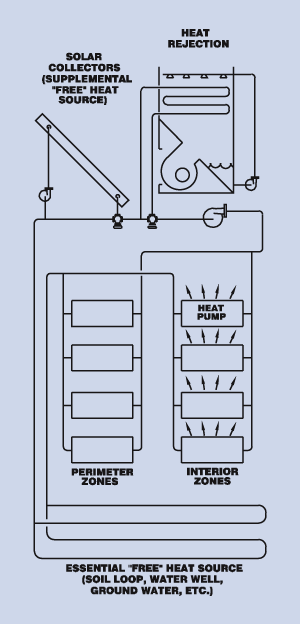Overview of…
5.6 Heat Pump Loop Systems
This part of the Energy Efficiency Manual shows you how to achieve the full energy saving potential of heat pump loop systems. In these systems, individual air-to-water heat pumps are connected to a common heat transfer water loop. When an individual heat pump is providing cooling, it rejects heat into the water loop. When an individual heat pump is providing heating, it takes heat from the loop.
Heat sources are needed for times when the total heating load of the system exceeds the total cooling load. Similarly, heat rejection equipment, such as a cooling tower, is needed to get rid of excess heat when the total cooling load of the system exceeds the total heating load.
You will gain a thorough understanding of the advantages of heat pump loop systems. The loop concept became popular as a way of transferring heat from the core zones of buildings to perimeter spaces during cold weather. A fundamental advantage is that the efficiency and capacity of the individual heat pump units do not have to be vulnerable to the outside air temperature.
Virtually any type of heat source can be connected to the system through the loop. “Free” or renewable sources, such as solar collectors or ground water, can be added to the system easily. Lakes, rivers, and the soil of the earth can be used as a heat sink to improve cooling efficiency. Thermal storage can be added to a loop system at relatively low cost.
At the same time, you will learn to minimize the efficiency shortcomings of loop systems. The water loop adds another stage of heat exchange, which reduces heat pump efficiency. The loop circulation pumps require additional energy to operate.
The design and application of heat pump loop systems are complex. Control is tricky. Unlike conventional heat pumps, you must select an appropriate combination of heat sources and heat sinks. Piping connections require careful planning. It is a challenge to get these systems to provide the efficiency benefit that they promise. Here you will learn to optimize system efficiency under all operating conditions.
Click here to return to the Table of Contents


